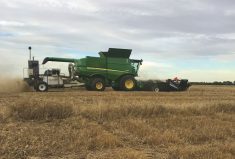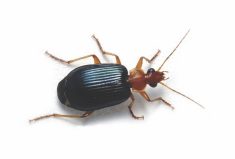Doing chores on a mixed farm in South Australia, Josh Lade dreamed of working on a really big grain farm. It was a dream that intensified as he was growing up, like when he used to put in shifts on the large inland grain operation owned by members of his mother’s side of the family.
Later he attended university to study agronomy, which he describes as his “big passion.” During that time he started to come into contact with research being conducted in Canada, and he started to get a glimpse of how farming is done over here.
Read Also

Producers aren’t panicking over tariffs and trade threats
The influence of tariff and trade uncertainity on farm business decisions.
“I saw the big, square fields, and I thought, ‘I want to see that,’” Lade says. “I wound up coming over to work for a farm, and they were looking for a longer-term solution, and it worked out well for all of us and I stayed.”
These days Lade lives and works near Osler, just north of Saskatoon, where he’s living the dream of a large-scale grain operation. But along with finding his dream in his adoptive country, Lade found the beginnings of a nightmare — the nightmare of run-away weed resistance, something his native land has been grappling with for years.
“I’ve seen it there, and I’m starting to see it here too,” Lade says. “I’ve seen a field sprayed and then walked into it a few days later and seen the weeds, still happily growing.”
Australian growers are definitely at the forefront of this global fight, having some of the earliest and most serious problems. But weed resistance is a challenge for growers the world over, and the reason why boils down to simple mathematics. In any naturally occurring population, there is variability of all sorts. In weed populations, this variability can include a handful of plants that can shake off chemical treatments and go on to not only survive, but also to produce seeds. After repeated applications of the same product, all that’s left of the population is basically this resistant subtype.
That means the efficacy of that herbicide is seriously reduced, putting all the more pressure on the remaining tools.
It’s this vicious feedback loop that has the major crop protection companies as concerned as anyone in agriculture over the development of resistance. Al Eadie is market development manager with Bayer CropScience, and he says it’s in everyone’s interests to guard the tools we have remaining.
“We really do need to protect them, because the hard reality is there isn’t anything in short and medium term in the pipeline to replace them,” Eadie says. “That’s true of our company, and to the best of my knowledge, all the other major companies. I talk to people in the business every day, and everyone is concerned about this, and taking it very seriously.”
Over time, there’s little doubt that new products will emerge, but the simple truth is that the crop protection business has already picked the low-hanging fruit, so newer products can be expected to be harder to identify and commercialize. There is also a worrying hold-over from the ‘glyphosate effect’ which saw off-patent glyphosate seriously cut into herbicide economics, dropping the amount that growers are willing to spend per acre and thereby also challenging the return-on-investment calculations for any company that wants to develop and register a new active.
Eadie says Bayer has produced guides on herbicide resistance for the Prairies. These can be found on the weed resistance website mixitup.ca and can help growers get their heads around the issue.
“The information is specific to issues in each of the three provinces, and will be relevant to farmers and the local challenges they face,” Eadie says. “I really would recommend growers visit the site and take a little time to familiarize themselves with the information.”
In fact, if anyone doubts just how serious this situation is, consider the actions of the major chemical companies. In a business that’s as bottom-line driven as any, you’re beginning to see a unique situation emerge where at times, companies find themselves increasingly in the unlikely position of recommending a competitor’s product.
“It might not be our product we wind up recommending this year, and we’re fine with that,” Eadie says. “In the end, if we can extend the life of these products, that’s good for all of us, farmers and crop protection companies alike. It will help us all have sustainable businesses.”
Lade says there are a lot of valuable lessons that Canadian growers can take from Australia. The climate might be different, but the crop mix and cropping systems are very similar, meaning at least some of the Down Under solutions are likely to be applicable to the Great White North.
Among the most valuable lessons, though at times the hardest, was that sometimes growers had to let the weed spectrum in their fields dictate their crop rotation.
“We all have to be profitable, there’s no doubt about that,” Lade says. “But we also have to make sure we remain profitable into the future.”
That might mean occasionally growing crops that aren’t immediately profitable, with an eye to longer-term sustainability of the operation, Lade says. He also strongly endorses having a herbicide rotation plan that delves into the various herbicide groupings, rather than simply swapping brand names, since frequently different chemicals are in the same family, resulting in continued selection pressure on the weed population.
More growers on board
More and more producers throughout the Prairies are getting on board the resistance management train, according to one agricultural research firm. Kent Fraser, VP of Stratus Ag Research, says a recent survey shows growers acknowledge resistance is an important issue, and they are taking a proactive approach on their farms.
“The numbers are very clear — about a third of farmers say they have some resistance on their farms,” Fraser says. “Twenty per cent say it has a big impact on how they farm, and 45 per cent of farmers in Western Canada expect it to have a big impact in the future.”
Fraser says more than 90 per cent of growers said that fighting weed resistance is good stewardship, because they expect they and their families to continue farming the land. About the same number said they were willing to change their farming practices to address the issue. About three-quarters of producers say they’ve already got a plan in place.
For the most part, Fraser says those plans appear to centre around exactly the sort of crop and product rotation systems that fit large-scale farm operations. In a way, Fraser describes an industry grappling with the art of the possible, adapting their production system to this new reality. He says there appear to be three major barriers that prevent farmers from adopting techniques and they can basically be boiled down to time, money and best agronomic practices.
For example, the survey respondents were reluctant to engage in practices that would slow down their seeding season, such as meticulously cleaning equipment between each field. They also predictably didn’t favour any solution that would significantly increase their cost of production, such as additional field operations. They were also extremely reluctant to step backwards and consider options like reincorporating summerfallow into their farms after the hard work of eliminating tillage through zero till.
In the end, Fraser says growers are simply learning this new reality and, through trial and error and experimentation, they’ll eventually settle on solutions that work under the reality of local production conditions. The important point, he says, is growers have gotten the message.
“They are definitely aware of this issue,” Fraser says. “It is clearly one of the things that is on their radar.”
Lade says he suspects growers may have to make some hard choices going forward, including adopting some practices in the middle ground, including cultural practices like tighter row spacing and heavier seeding rates, among others. Those might not be entirely palatable, but he says watching the situation back home has convinced him that there are even worse things waiting in the wings.
“It’s gotten so bad that some people have had to pull the mouldboard plow back out and they’re turning the top six inches of their fields and burying the weed seeds deep,” Lade says. “That’s definitely not somewhere you want to go.”
















